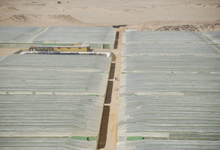 The total surface area of arable lands in the region is about 7500 hectares, including 50 hectares of irrigated lands and 1000 hectares of irrigatable lands. The irrigated plots are chiefly dedicated to fodder cultivation (alfalfa).
The total surface area of arable lands in the region is about 7500 hectares, including 50 hectares of irrigated lands and 1000 hectares of irrigatable lands. The irrigated plots are chiefly dedicated to fodder cultivation (alfalfa).
In this arid area, there are two kinds of agricultural exploitation: irrigated lands and lowlands.
Irrigated lands represent the main and most productive agricultural areas. Their surface area yet has diminished under the effect of desertification and water scarcity. For this reason, cultivated lands in Laayoune undergo very important changes. Thus, the surface area may decrease exceptionally during drought periods to 300 up to 400 hectares; on the other hand, during rainfall periods, they may reach 7000 hectares.
Stock-rearing
The region has an important livestock which constitutes the central source of income for farmers. The present numbers of livestock in the region as follows:
Camels and goats occupy a pre-eminent position in stock-rearing in Saharan provinces. Their number is estimated at around 89.500 head of camels, which represents 30% of the national camel stock, and 193.000 head of goats, which is 4% of the national goat stock. They are followed by sheep, whose total number amounts to 120.300 head, representing only 0.80% of the national sheep stock. As for cattle, the region has 440 head of cattle, which is 0.01% of the national cattle stock. Pasturing in this arid area relies on transhumant and nomadic stock-rearing. Most stockbreeders are from urban areas, monitoring their livestock from Laayoune or Boujdour, and usually have a secondary activity, especially in the tertiary sector.
Their livestock move downwards to Dakhla or the Mauritanian bordersm or upwards to Smara, Guelmim and Souss. The itinerant livestock is supervised by a number of employees and shepherds. These keep moving between Laayoune-Boujdour and pastoral areas to see to the livestock (complementary food in a bad season, special products for animal health, carrying livestock destined for sale or slaughtering….) and supply shepherds with food, water, etc).
Stock-rearing remains the central and most productive activity in this region, and boasts of course huge potentials that are beyond those of agriculture.